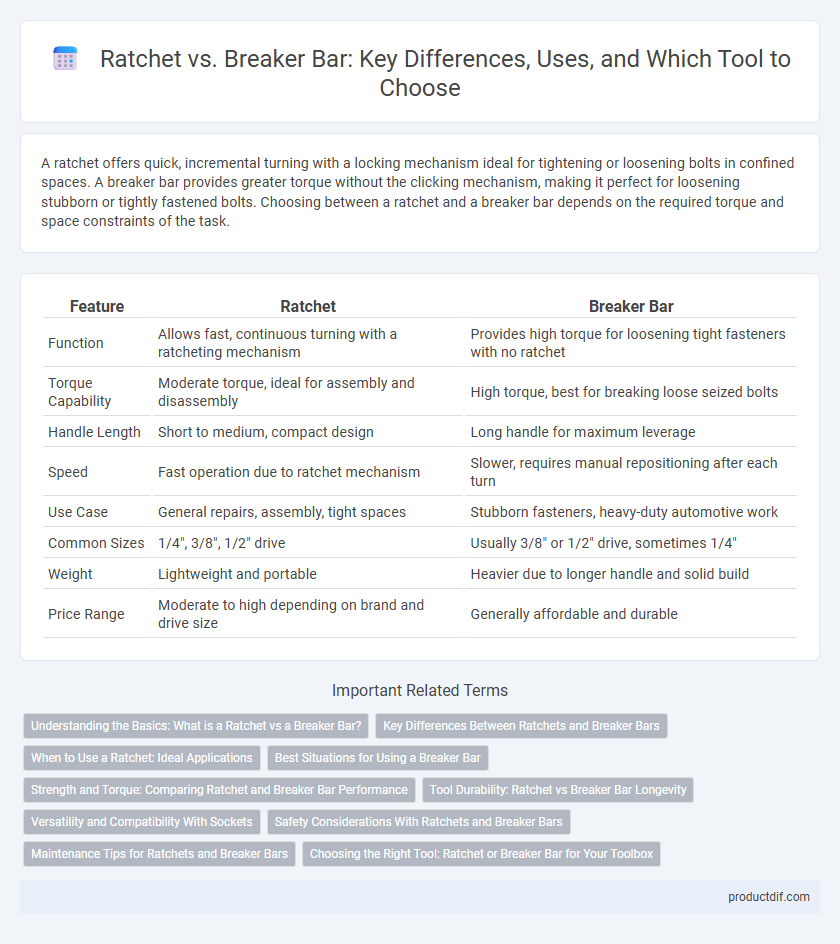A ratchet offers quick, incremental turning with a locking mechanism ideal for tightening or loosening bolts in confined spaces. A breaker bar provides greater torque without the clicking mechanism, making it perfect for loosening stubborn or tightly fastened bolts. Choosing between a ratchet and a breaker bar depends on the required torque and space constraints of the task.
Table of Comparison
| Feature | Ratchet | Breaker Bar |
|---|---|---|
| Function | Allows fast, continuous turning with a ratcheting mechanism | Provides high torque for loosening tight fasteners with no ratchet |
| Torque Capability | Moderate torque, ideal for assembly and disassembly | High torque, best for breaking loose seized bolts |
| Handle Length | Short to medium, compact design | Long handle for maximum leverage |
| Speed | Fast operation due to ratchet mechanism | Slower, requires manual repositioning after each turn |
| Use Case | General repairs, assembly, tight spaces | Stubborn fasteners, heavy-duty automotive work |
| Common Sizes | 1/4", 3/8", 1/2" drive | Usually 3/8" or 1/2" drive, sometimes 1/4" |
| Weight | Lightweight and portable | Heavier due to longer handle and solid build |
| Price Range | Moderate to high depending on brand and drive size | Generally affordable and durable |
Understanding the Basics: What is a Ratchet vs a Breaker Bar?
A ratchet is a hand tool featuring a socket attached to a gear mechanism that allows for continuous motion in one direction without removing the socket from the fastener, ideal for tightening or loosening bolts in confined spaces. A breaker bar, by contrast, is a long, non-ratcheting bar designed to generate high torque to loosen stubborn or seized fasteners through leverage. Understanding the fundamental difference lies in their core functions: ratchets provide efficiency and speed with repetitive turning, while breaker bars deliver maximum force for initial loosening.
Key Differences Between Ratchets and Breaker Bars
Ratchets feature a gear mechanism allowing for quick, repetitive turning in confined spaces, making them ideal for precision work with sockets. Breaker bars provide extended leverage without a ratcheting mechanism, enabling them to loosen extremely tight or rusted fasteners by applying higher torque. The key difference lies in their functionality and design: ratchets emphasize speed and convenience, while breaker bars focus on maximum force and durability.
When to Use a Ratchet: Ideal Applications
A ratchet is ideal for tightening or loosening fasteners in confined spaces where continuous turning is necessary without repositioning the tool. It excels in automotive repairs, assembly tasks, and general mechanical work requiring precise torque control. Use a ratchet when speed and frequent direction changes are essential to efficiently handle bolts and nuts.
Best Situations for Using a Breaker Bar
A breaker bar excels in situations requiring maximum torque to loosen stubborn or rusted fasteners, making it ideal for automotive repairs like removing lug nuts or seized bolts. Its long handle provides greater leverage compared to a ratchet, reducing user effort on tough jobs where a ratchet might slip or break. Breaker bars are not suited for tightening fasteners or working in confined spaces, where precise control and socket flexibility of ratchets are preferable.
Strength and Torque: Comparing Ratchet and Breaker Bar Performance
Breaker bars deliver higher torque and greater strength than ratchets, making them ideal for loosening stubborn or rusted fasteners. Ratchets provide convenience and speed with locked gear mechanisms but have limited torque capacity compared to breaker bars. For heavy-duty applications, breaker bars are preferred due to their long handle design, which offers superior leverage and force.
Tool Durability: Ratchet vs Breaker Bar Longevity
Ratchets typically feature complex internal mechanisms with multiple moving parts, which can wear out over time and slightly diminish their durability compared to breaker bars. Breaker bars have a simpler, solid steel construction, making them more resistant to stress and less prone to mechanical failure, resulting in longer tool longevity under heavy torque applications. The choice between ratchet and breaker bar durability largely depends on the intensity of use and maintenance, where breaker bars generally outperform ratchets in lifespan due to robust design.
Versatility and Compatibility With Sockets
Ratchets offer superior versatility with quick socket changes and the ability to switch directions effortlessly, making them compatible with a wide range of socket sizes for various mechanical tasks. Breaker bars provide greater torque for loosening stubborn fasteners but lack the ratchet mechanism, limiting their compatibility to socket engagement without directional changes. Both tools accommodate standard socket sizes, but ratchets excel in adaptability for diverse automotive and repair applications.
Safety Considerations With Ratchets and Breaker Bars
Ratchets offer controlled torque application, reducing the risk of sudden slips and injuries during repetitive tightening or loosening tasks. Breaker bars provide higher leverage for loosening stubborn fasteners but require careful handling to avoid overextension and potential wrist strain or tool breakage. Using the appropriate tool for the task and wearing protective gloves significantly enhances safety during mechanical work.
Maintenance Tips for Ratchets and Breaker Bars
Regular lubrication of ratchet gears prevents wear and ensures smooth operation, while inspecting breaker bars for cracks or bends maintains their structural integrity. Proper storage in a dry environment minimizes rust and prolongs tool lifespan. Using the correct torque and avoiding overextension reduces damage to both ratchets and breaker bars, optimizing performance and durability.
Choosing the Right Tool: Ratchet or Breaker Bar for Your Toolbox
Choosing between a ratchet and a breaker bar depends on the task's torque requirements and precision needs. Ratchets offer speed and convenience with their quick-release mechanism, making them ideal for tightening or loosening fasteners in tight spaces. Breaker bars provide higher leverage for stubborn bolts, delivering increased torque without the risk of damaging the tool or fastener.
Ratchet vs Breaker Bar Infographic

 productdif.com
productdif.com